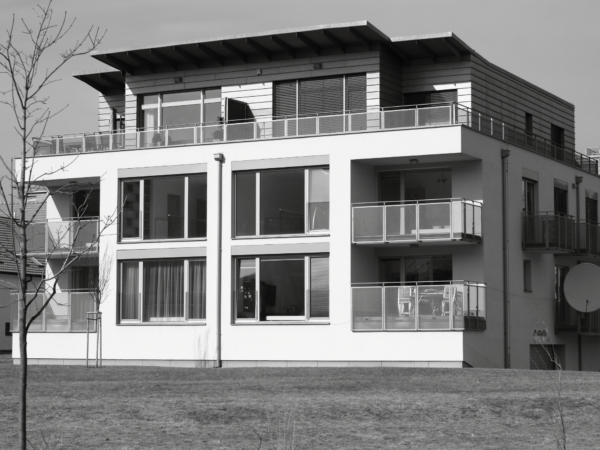What do you know about flat roofing? It’s a stylish roofing solution with more technological advances than ever before. While it comes with many benefits, it’s not the ideal solution for every structure! Here are five factors to consider when looking at a flat roof for your building.
Flat Roofs Aren’t Completely Flat
 When we talk about flat roofs, we must tell you that flat roofs aren’t necessarily flat – almost all will slope. If engineered correctly, it will be a slight slope that you may not even notice. Whether or not you see it, you’ll benefit from its work after a heavy rainstorm or snowmelt: the slight pitch helps to mitigate any potential water pooling and improve drainage.
When we talk about flat roofs, we must tell you that flat roofs aren’t necessarily flat – almost all will slope. If engineered correctly, it will be a slight slope that you may not even notice. Whether or not you see it, you’ll benefit from its work after a heavy rainstorm or snowmelt: the slight pitch helps to mitigate any potential water pooling and improve drainage.
Flat Roofs Make It Easy To Keep Your Building Cool
A flat roof may be trendy and fit in with your building’s design, but it serves a purpose for conserving energy. Covering a flat roof in a UV reflective coating helps keep the temperature of the materials down. It also uses a rigid insulation and membrane system that is more efficient than the cavity system of a pitched roof.
Flat roofing is reflective, bouncing the UV rays back from the roof structure. The building underneath the roof stays cool, making it better for living, working, or shopping in, and the air conditioning system won’t have to run as frequently during hot summer weather.
Flat Roofs Need Frequent Cleaning
Flat roofs have many benefits, but building owners must consider that they need to be cleaned more frequently than pitched roofs. Dirt, lichen, moss, and mould can all become issues that aren’t just aesthetic – these issues can eat at the roof’s protective membrane, leading to leaks. Keeping your flat roof free of debris and vegetation lets the membrane function properly and channel water off the surface.
One issue comes from birds. Their droppings can put a strain on any roof, but it’s a problem on flat ones: the surface is an ideal spot that few birds can resist. The acid in the droppings eat away at the cover, causing leaks that require costly repairs. When installing a flat roof, the design should be unattractive to birds, and the problems with the acidic content of the droppings will disappear.
Flat Roofs Are Better Suited For Commercial Purposes
Flat roofs aren’t feasible for homes. Houses have sloped roofs so that no rain or less snow can build up. Commercial buildings, however, cover a much larger surface, and to build a slope tall enough for the runoff on a large commercial building would be impractical, dangerous and difficult. Flat roofs implement other means for getting rid of runoff.
The low costs of installation and maintenance offered by flat roofs – all while covering a higher amount of square footage – are ideal for the owners and operators of commercial buildings. A flat roof also provides space for the HVAC system, which, for commercial purposes, is often much bigger than a residential one. The system can be tucked away on the roof and provide ample space for repair persons to access the system and perform maintenance.
A Flat Roof Can Be More Than Just A Roof!
 A flat roof is an opportunity to green up your building, reduce the heat given off your structure, and maybe even make a little money on the side. The flat roof of a business or apartment building is an opportunity for urban gardening. Many are an ideal space for growing flowers or vegetables – even keeping bees. Building owners and managers can use less energy to save money, protect the roofing membrane, and conserve resources for our planet’s future!
A flat roof is an opportunity to green up your building, reduce the heat given off your structure, and maybe even make a little money on the side. The flat roof of a business or apartment building is an opportunity for urban gardening. Many are an ideal space for growing flowers or vegetables – even keeping bees. Building owners and managers can use less energy to save money, protect the roofing membrane, and conserve resources for our planet’s future!












